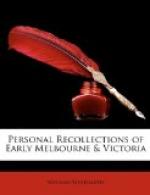I used to traverse not a few dreary empty allotments in the hot summer sun to reach the stores of my friend the Honourable James Graham, whose dwelling and business place in Russell, by Bourke street, seemed then quite far out of the village, but is since in the very heart of the great city. The course of values in the colony, early and late, is well illustrated by this example. The allotment originally belonged to our friend in common, S.A. Donaldson, of Sydney, who had bought for some nominal price at the Government sale in 1837. He bought many other lots thereabout, and towards Collingwood, further east and north; and after the gold discoveries, he told me pathetically, oftener than once, that his impatience to sell had lost him the status and happiness—whatever the latter might be—of a millionaire. Donaldson had let this place, with its house, stores, etc., good as these things went then, to Graham, at 500 pounds a year. This was about 1838-9, when everything in business ways was rolling jollily upwards. But some few years afterwards the landlord’s attorneys, William Ryrie and myself, had to reduce the rent to either 100 or 50 pounds—I think the latter. Some years later, Graham purchased at 2,000 pounds, and it is understood has lately resold at something approaching a quarter of a million. As these matters are all locally so well known, I feel that, as with wills at Doctor’s Commons, I tread upon no toes in such useful illustrations.




